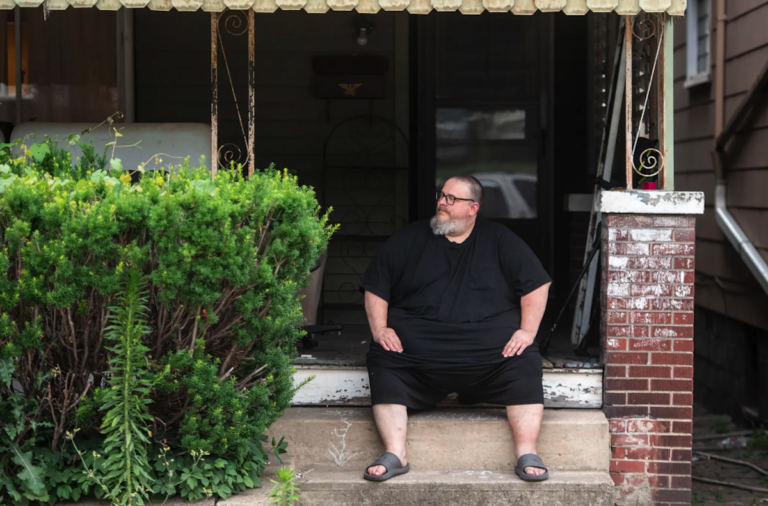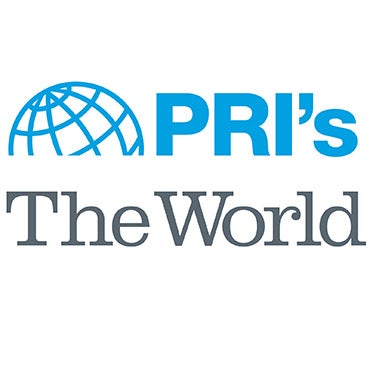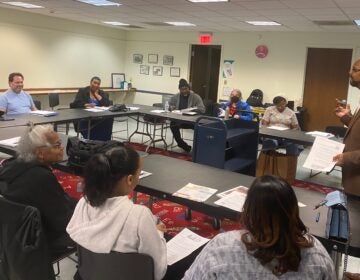‘It shouldn’t be this difficult’: Pa. homeowners desperate as mortgage aid struggles drag on
Pa. promised fixes for a troubled mortgage relief program. Months later, problems persist, new challenges have emerged, and thousands of homeowners are still waiting for help.

Mike Ramsey sits on the front porch of his house. (Nate Smallwood for Spotlight PA)
This story originally appeared on Spotlight PA.
The water had been off for seven weeks and his best hope of getting it back on remained just out of reach, so Mike Ramsey swallowed his pride and began typing out one more email begging for help.
Maybe things would go differently this time.
Ramsey, 49, had been brushing his teeth with bottled water, trying to use as little as possible because the cost of buying five or six cases each week quickly added up. Desperate for a shower, he wiped himself down with a damp cloth every few days instead. He hadn’t felt clean in weeks.
“I mean no disrespect and I do appreciate all your help thus far,” he wrote to more than a dozen top officials at the Pennsylvania Housing Finance Agency, which runs a $350 million program that promises to help homeowners recover from the pandemic but has been hamstrung by internal crises.
Before the water was shut off, a program worker had assured Ramsey that his application was under review. Then the program was plunged into a series of upheavals.
Almost fifteen months after hiring a company to run the program, PHFA ended the contract, citing a long list of problems: clunky software, long delays, unfair denials. The agency said it would take over, promising improvements. But state officials did not realize the scale of the problems.
The number of pending applications was three times larger than they initially believed.
Ramsey had already received help with his property taxes and electric bill, he explained in the email. But his water had been shut off in early March and it was now the last week of April. The program had promised to prioritize the applicants in “greatest need,” including those at risk of having their utilities turned off, and wouldn’t that include him? “Everything else is good now…” he wrote. “I just have no water.”
In June, PHFA Executive Director Robin Wiessmann told state lawmakers during a committee meeting that she was “very comfortable” that wait times were dropping once applicants were registered in the new system and “very confident about where the agency currently is.”
Almost five months after the state took over, however, problems persist, the transition has in some cases created new ones, and the agency has barely made a dent in the backlog. Many homeowners are no closer to receiving aid than they were at the start of the year.
Among the findings of Spotlight PA’s follow-up investigation:
- Due to legal requirements, homeowners with pending applications must register in the new system before they can get help. By late July, however, only about half the applications had been registered, partly because of widespread confusion over the process. As a result, thousands of homeowners, many of whom have already waited months for help, are still in limbo.
- Most homeowners who have successfully signed up for the new system still haven’t had their applications reviewed. Even fewer have actually received assistance. As of late July, almost 9,500 applications had been registered, but only about 900 had been fully paid out.
- Some homeowners found that ongoing mortgage payments the program had promised to cover stopped without warning, and were sent into a panic over how to handle bills the state had already said it would pay.
- PHFA doesn’t always have a clear picture of who is most in need, compromising its ability to prioritize the most at-risk homeowners.
- The program stopped accepting new applications in February, with only a few days’ notice. The pause bought PHFA time to resolve the backlog, but cut off homeowners who would otherwise qualify for help.
In a statement, PHFA spokesperson Scott Elliott acknowledged that the transition “took longer than anticipated,” but said the agency had to ensure the information it received from the contractor was accurate. Registering mortgage and utility companies in the new system has also been time-consuming, he said.
Left with few concrete answers and no sense of how much longer they will have to wait, many homeowners like Ramsey feel betrayed by a program that seemed to offer a lifeline but has often felt more like false hope.
Ramsey kept sending emails and calling the help desk, but his application didn’t seem to move. Program workers kept telling him: We’re still transferring the data. Wait for the email to register in the new system. Please be patient.
When he felt angry, or dismissed, during these calls, Ramsey tried to remember that the person on the other end of the phone was having the same conversation over and over, that their hands were tied, that other people, he thought, probably had it a lot worse. But as the water remained off, he fell into despair.
In the first days after the shutoff, he kept going to turn on the tap. As the weeks passed, he settled into an uneasy new routine. No shower. Takeout food on paper plates. Calling the program. No updates. No email. No shower. Flushing the toilet only every few days, after filling it from gallon jugs of water. Calling the program. No updates. No email. No shower.
How we reported this story:
Spotlight PA first reported on the difficulties homeowners faced in getting help from the PAHAF program in January and has been following the story since. Over several months, we spoke to more than a dozen homeowners waiting for help. The applicants quoted in the story shared emails, text messages, court records, utility bills, and program documents with Spotlight PA to corroborate their accounts.
PHFA spokesperson Scott Elliott declined to answer questions from Spotlight PA about specific applications, even with written permission from the homeowner. Instead, Spotlight PA shared questions with the applicants named in the story to send to Elliott directly.
PHFA officials also provided written responses to questions from Spotlight PA over the course of several months and spoke with a reporter in an hour-long interview before publication.
IEM answered questions in an interview with a senior executive and in writing. With the applicants’ permission, IEM also provided written responses about two cases that overlapped with the company’s work on the program.
We also talked to Legal Aid attorneys and housing counselors who have been helping people with their applications.
Spotlight PA also reviewed internal emails, memos, spreadsheets, and complaints about the program obtained through Right-to-Know requests to PHFA and Gov. Josh Shapiro’s office.
A ‘complacent response’
The problems began before the program even opened.
Pennsylvania received $350 million from the federal government to help homeowners recover from the pandemic. State lawmakers put PHFA in charge of distributing the aid. Concerned that this would overwhelm the agency’s other operations, officials decided to hire a contractor. They settled on Innovative Emergency Management, Inc., a company with years of experience overseeing state disaster relief efforts.
Once the Pennsylvania Homeowner Assistance Fund launched in February 2022, thousands of applications flooded in. Neither IEM’s staff nor its software was ready, state officials would later say. An IEM spokesperson denied this, as well as many of the agency’s other criticisms.
The fund offers homeowners up to $50,000 to help with mortgage payments, utility bills, property taxes, and other housing costs. But as a Spotlight PA investigation previously uncovered, many homeowners faced long, uncertain waits. They often complained that their IEM caseworkers stopped responding to them. Sometimes, applicants were left in the dark about policies that added to the delays. Some had their utilities shut off while waiting.
“This sounded like a program that could help,” one applicant told then-Gov. Tom Wolf’s office last summer. “But this is turning out to be the opposite.”
By December, there was a backlog of thousands of applications, according to a memo shared internally by PHFA’s contract manager. Many dated back to when the program opened, 10 months earlier.
Advocates and state lawmakers were complaining, the memo said. Responding to public records requests, officials found messages from IEM to applicants “that were not consistent with the level of professionalism and knowledge expected.” When PHFA officials asked to see under the hood of the company’s software for handling applications, they found that “the processing steps were labor intensive and not automated,” the memo said, in contrast to what IEM had proposed when bidding on the contract. North Carolina and Virginia, which had also hired IEM to run their programs, were having similar problems with the company, the memo noted.
When PHFA tried to address these problems with IEM, the memo said, they received a “complacent response.”
In an interview, Jon Mabry, IEM’s vice president of disaster recovery, said the agency’s own missteps contributed to the delays. State officials kept changing the policies, he said, which slowed down the processing of applications. IEM had to communicate with more than 1,000 mortgage and utility companies to confirm how much applicants owed, which was labor-intensive and often required multiple follow-ups, he said. When companies wouldn’t use the automated system, IEM had to process that information by hand.
PHFA’s decision to end the contract — announced four days after Spotlight PA’s initial investigation — came as a surprise, Mabry said. “Everything was trending in the right direction.”
Federal data shows the amount of aid paid out each quarter had steadily increased over the course of 2022.
PHFA officials didn’t think that was enough. To get things back on track, they decided, the agency should run the program itself.
‘It shouldn’t be this difficult’
In February, PHFA prepared a list of FAQs for staff about the upcoming changes.
“What makes you think PHFA can do better?”
“What actions are being taken to prevent similar issues from arising again?”
“How can you guarantee that homeowners who have been waiting for months for financial relief won’t be further delayed by the transition?”
The agency could not guarantee it. By the time PHFA took over, some applicants had already been waiting for more than a year. But officials decided that in the long-term the changes would be worth the temporary disruption. The disruption, however, has lasted far longer than they anticipated.
When PHFA decided to take over from IEM, officials thought there was a backlog of roughly 6,000 applications. The real number, they later learned, was three times as large.
Mabry, the IEM executive, said this number should not have come as a surprise, since the company sent PHFA daily reports with detailed application data. Elliott, the PHFA spokesperson, said the reports did not clearly define the status of pending applications.
Part of the problem, emails show, was a miscommunication over the word “backlog.” PHFA thought it meant any applications not yet completed, while IEM defined it more narrowly. “I am really confused,” a PHFA official told an IEM manager via email as the discrepancy came to light.
Transferring the more than 18,000 pending applications took months.
Then another problem emerged: getting homeowners to register in the new system. Until they do this, their applications cannot progress and they cannot receive assistance.
PHFA said homeowners would receive an email with the link to sign up. But according to advocates, many applicants said they never got it. Those who did often found the registration process confusing. One legal aid attorney said almost all of her clients needed help completing it.
For many of those waiting for assistance, the stakes are high. Of the applicants who had registered in the new system as of mid-July, more than 2,300 said they were at risk of foreclosure, according to PHFA. More than 2,800 said they were at risk of having their electricity disconnected, while more than 1,600 said they were at risk of having their water shut off.
Laurie Ramsdale’s house in Schuylkill County has been in her family for over 100 years. The house is scheduled to be sold in September unless she catches up on almost $2,400 in back taxes.
Ramsdale, 50, applied for help in January, before PHFA took over. By May, she still hadn’t received the sign-up link, so she started searching online. Someone had shared the link on a Reddit page for applicants. She clicked on it and began to register, but partway through, panicked that it might be a scam and stopped.
She later finished registering, after confirming it was legitimate. A worker told her the program was checking whether she qualified. As the tax sale grew closer, Ramsdale felt as if her application had made no progress in the five months since she had submitted it.
“It shouldn’t be this difficult,” she said.
PHFA would not answer questions from Spotlight PA about specific cases, even with written permission from applicants. But the agency did respond to questions directly from homeowners, telling Ramsdale that the sign-up email might have gone into her spam folder.
Elliott, the PHFA spokesperson, said homeowners do not have to submit documents from their original applications for a second time. Some applicants are confused, though, because the registration portal warns, in red type, that certain documents are “required” and that applications “cannot be reviewed” until they are provided, screenshots show.
Ramsdale thought she had to dig up and resubmit documents she’d already uploaded months earlier. In mid-June, too late to help Ramsdale, PHFA added instructions to the program’s website clarifying this, and publicly posted the link to register.
Other guidance to applicants, though, has also been confusing. Recent social media posts said homeowners were being asked “to perform a simple access point setup” to help “quicken the review of applications” — without spelling out that if they didn’t, they could not receive assistance. Elliott said most of the agency’s social media posts make the stakes clear.
Timeline:
- October 7, 2021 – PHFA signs contract with IEM to run the program.
- February 1, 2022 – The Pennsylvania Homeowner Assistance fund opens.
- January 27, 2023 – PHFA announces it will end the contract with IEM.
- February 1, 2023 – The program stops taking new applications.
- March 9, 2023 – PHFA takes over.
By late July, many applicants still weren’t even in line to receive assistance; about 48% of applications had not been registered.
The agency has been calling applicants to remind them to sign up, as well as sending instructions in the mail and via email, and holding in-person events across the state, Elliott said.
Once applicants have registered, they face another wait: around two months, on average, according to PHFA.
The delays have now dragged on for so long that some applicants have likely given up on getting help. In some cases, homeowners can work out an arrangement with their mortgage companies to catch up on late payments, although rising interest rates have made this unaffordable for many borrowers. Others may have sold their homes.
Aid programs like this one are the best option for many homeowners who have fallen behind, but deciding whether to wait for assistance with the threat of foreclosure looming is an almost impossible choice, said Stacey Tutt, an attorney at the National Housing Law Project. “There’s so much uncertainty.”

‘A shroud over my head’
Patty Pollock only found out about the program once she was on the brink of losing her home.
By the time she applied last December, Pollock, 67, was thousands of dollars behind on her mortgage, facing foreclosure, and in desperate need of help. Less than two weeks later, her mortgage company won a default judgment against her, giving it the right to eventually sell her home of almost 24 years.
Pollock sent the judgment to IEM.
Three months later, she sat on the witness stand in a Columbia County courtroom, her mouth turned down in worry.
The hearing was a last-ditch attempt to undo the foreclosure judgment against her.
Her attorney asked whether she had any solid information about her application.
“100% no.”
Homeowners with federally backed mortgages, like Pollock, were supposed to be protected from foreclosure for up to 60 days while they waited for help.
What if I'm still waiting?
- Your application cannot move forward until you register in the new system. PHFA has now made the sign-up link, and instructions, publicly available.
- PHFA sent applicants who haven’t registered another email, as well as a letter in the mail.
- If you have a pending foreclosure case, contact a Legal Aid organization in your area if you haven’t already done so.
- If you receive a foreclosure or shut-off notice, make sure to send it to the program.

But that protection only kicks in once the program — not the homeowner — tells a mortgage company someone has applied. As Pollock sat in court that day, her loan servicer had not heard from PHFA or IEM.
Her case was stuck in a bureaucratic no man’s land.
An IEM spokesperson said that under the program’s rules, Pollock’s case didn’t meet the criteria for “immediate escalation” because her house was not scheduled to be sold.
As a result, her application still hadn’t been fully reviewed by the time her file was passed on to PHFA, two months before the hearing.
Elliott, the PHFA spokesperson, said the agency would only contact an applicant’s mortgage company once their file had been “selected for processing” and they were deemed eligible.
Trying not to lose faith in the program, Pollock drove home to wait for the judge’s ruling.
Her house was her sanctuary, but now it felt temporary, so she stopped mowing the grass. Spring was coming, but she didn’t plant flowers in her front yard, or move her wicker furniture onto the front porch, where wind chimes and potted ferns hung in the shade.
The foreclosure case was always on her mind. She couldn’t focus. Small things made her cry. She turned down invitations from friends. “It was like there was a shroud over my head and I couldn’t get rid of it,” she said.
Housing advocates fear that homeowners facing foreclosure could slip through the cracks while they wait and in late June urged PHFA to do more to protect them, by providing a list of applicants to local judges.
Robin Wiessmann, the agency’s executive director, wrote to judges and court administrators in July telling them about the delays and the program’s efforts to expedite applications for those at the greatest risk. PHFA said it would not give courts the names of applicants because of privacy concerns.
Advocates also asked the agency to petition the state Supreme Court to halt foreclosures for homeowners who are still waiting; Elliott said PHFA decided against this due to “logistics and case law.”
In response to questions from Pollock, the agency said she had not indicated she was in foreclosure when she registered in the new system. Pollock couldn’t remember the details of the sign-up process, which she said she completed in late April. But she said she had called and emailed the agency about her foreclosure case multiple times. Her attorney also contacted the program about the case in February, emails show.
In the weeks after the hearing, Pollock worried about whether to file for bankruptcy, and how she would find a place to rent with her two German shepherds.
She thought about locking the door behind her and walking away from the house, or locking the door and staying inside for as long as she could. It felt like living on borrowed time, she said. She could not bring herself to tell her sons about the foreclosure case.
Finally, in May, Pollock got the news she had been hoping for: The judge agreed to reopen the case, taking it one step backward.
At last, she bought yellow flowers to plant in the yard: begonias, bidens and sunflowers.
She finally had a caseworker, but she still didn’t know for sure whether the program would be able to help her. She was still facing foreclosure. She tried not to get her hopes up.
Another wait stretched ahead.
‘I thought this was the end of my stress’
Even some homeowners who had already begun receiving assistance found that it could stop abruptly.
In early January, the program agreed to cover the mortgage payments on Jennnifer Swahl’s house in Chester County for the next six months. The money for February and March arrived promptly. But by April 15, she said, the payment still had not appeared and Swahl, 54, was officially late.
She scrambled to cover it herself, letting her car payment and electric bill slide as the safety net she had been promised disintegrated beneath her.
Other applicants were having the same problem. One homeowner told Gov. Josh Shapiro’s office in April that they fell behind on their mortgage and received a foreclosure warning notice after the program failed to make payments it was supposed to cover. Another homeowner who said their payments stopped told Shapiro’s office the following week: “I thought this was the end of my stress over my house but it has begun all over again.”
In an attempt to close out applications before IEM’s contract ended, PHFA told the company to bundle ongoing mortgage assistance into a lump sum instead of making monthly payments. This led to confusion among mortgage companies over how to apply the money to homeowners’ accounts. The agency then told IEM to stop paying out ongoing mortgage assistance altogether, state records show. PHFA said it would handle those payments instead — but the agency said it could not resume the payments until applicants registered in the new system.
Swahl’s mortgage company received the rest of the money in June, two months after the payments stopped.
Elliott declined to say how many homeowners were affected, but acknowledged that PHFA should have told them payments would be disrupted.
‘Your application is in limbo’
After applying for assistance last summer, Mike Ramsey received thousands of dollars to catch up on his electricity bill and late property taxes. But his financial problems weren’t over.
In December, he said, he left his job as a bus dispatcher. For years, he had missed more and more work as he tried to push through heart problems, high blood pressure, and bad knees that made sitting at a desk for hours unbearably painful.
In February, a notice from the local water authority warned Ramsey that he was almost $1,000 behind and 10 days away from having his service shut off. He sent the notice to his IEM caseworker. The timing could hardly have been worse.
In late February, IEM signed up Ramsey’s local water authority for the program. But the deadline for PHFA to take over was nearing and time was running out. The company did not receive the information it needed from the water authority in order to make a payment before its last day of work on the program, in early March, an IEM spokesperson said.
PHFA initially ended its contract with IEM without saying the company was at fault. Then a plan to have IEM close out thousands of applications, including Ramsey’s, fell apart after PHFA discovered new problems with the company’s performance. The agency said IEM had fallen short from the start of the contract; the company denied this and threatened legal action. The two sides eventually agreed to a truce, pending the results of a PHFA investigation.
Ramsey, meanwhile, had no water and no answers. In late March, a program worker told him, via email, that until PHFA had transferred all the files from IEM’s system, they couldn’t provide information about specific applications. He received the exact same email a month later.
The program referred him to a nonprofit specializing in utility law, but a paralegal there told him that since his water was already off, there was nothing they could do. Unless PHFA manually migrated his file into the new system, or sent him the sign-up link, she told him in an email, “your application is in limbo and will not be processed.”
In response to questions from Ramsey, PHFA said it had not been informed that his water was off — although Ramsey had told multiple people at the agency in more than a dozen phone calls and at least seven emails, including one with the subject line: “!!! PLEASE READ, MY WATER HAS BEEN SHUT OFF FOR 2 MONTHS !!!”
The agency also said the link to register was sent to the email address Ramsey used when he first applied, last year, not the one he gave when he called the help desk. Ramsey’s messages, however, show he had been contacting the program for months using the email address he applied with.
After 10 weeks with no water, Ramsey’s service was finally restored in May.
 Spotlight PA is an independent, non-partisan newsroom powered by The Philadelphia Inquirer in partnership with PennLive/The Patriot-News, TribLIVE/Pittsburgh Tribune-Review, and WITF Public Media.
Spotlight PA is an independent, non-partisan newsroom powered by The Philadelphia Inquirer in partnership with PennLive/The Patriot-News, TribLIVE/Pittsburgh Tribune-Review, and WITF Public Media.

Get daily updates from WHYY News!
WHYY is your source for fact-based, in-depth journalism and information. As a nonprofit organization, we rely on financial support from readers like you. Please give today.




